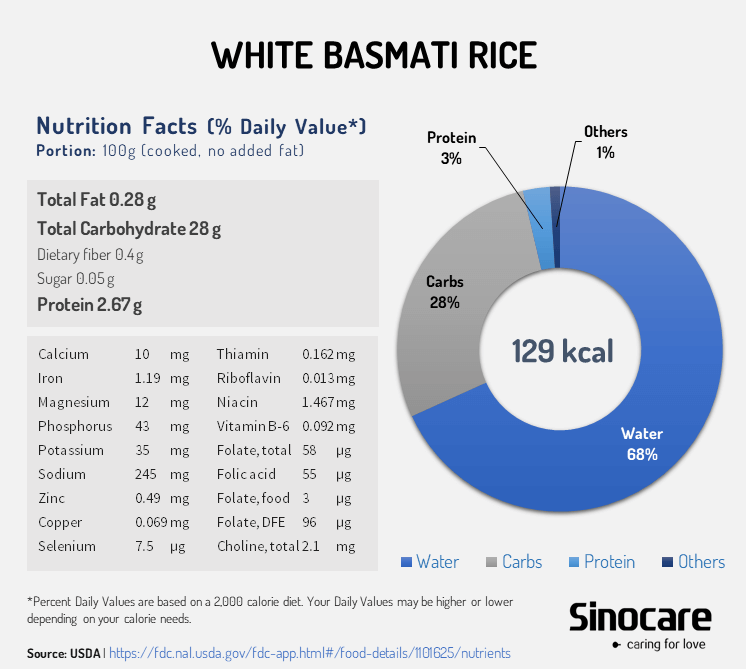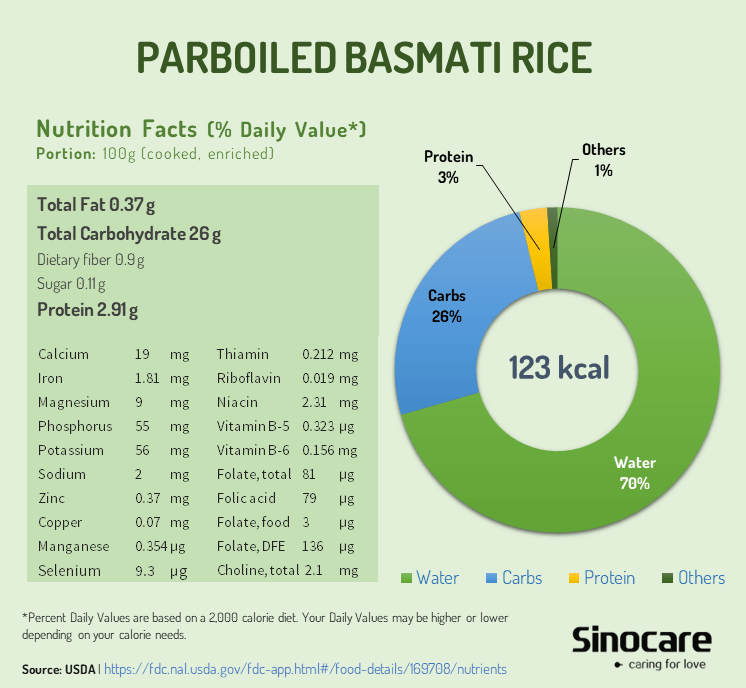Managing diabetes means making informed choices about the foods we eat. One staple food that may raise concerns is rice owing to its high carbohydrate content.
Basmati rice is no exception—a popular rice variety with a distinct aroma and fluffy texture. It also goes by the name “queen of perfumed rice” in some places. People with diabetes thus often wonder whether basmati rice is a friend or foe for them.
In this article, we’ll unveil the facts about basmati rice, from its nutritional content to its impact on blood sugar levels. Plus, we’ll answer some frequently asked questions concerning basmati rice and diabetes.
So, let’s embark on this culinary adventure and explore the world of basmati rice together!
Nutritional Value of Basmati Rice
Basmati rice comes packed with essential nutrients like carbs, protein, fibre, amino acids, and numerous vitamins and minerals.
However, how much nutrients one can get will depend on the type of basmati rice consumed. There are many types of basmati rice out there. The APEDA in India tells us of 34 different varieties of basmati rice. [1]
Basmati rice typically comes in three varieties depending on how it is processed:
- White Basmati Rice: We are all more or less familiar with this basmati rice variety. It is known for its long, slender grains. Milling the rice grains removes the outer husk and bran layers, giving them a polished white appearance. However, the milling also strips away some nutrients. This removal makes white basmati rice less nutritious than brown basmati rice. [2, 3]
- Brown basmati rice: This type of rice does not go through the milling process. Traditional methods remove only the outer husk, leaving the bran layer intact. As a result, brown basmati rice keeps almost all of its natural nutrients. [3, 4]
- Parboiled basmati rice: This rice form undergoes a unique process called parboiling. This process involves partially boiling and slowly drying the rice grains in their husk before milling. Parboiling helps the grains retain essential nutrients by driving them from the bran layer into the starchy endosperm. Hence, the rice has a higher nutritional content than regular white basmati rice. [5, 6]
The below infographic shows the nutritional contents of these three forms of basmati rice.



Calories in Basmati Rice
Basmati rice has comparatively fewer calories than other available rice varieties on the market. However, how many calories each serving offers can vary depending on the type of basmati rice consumed. A 100-gram serving of cooked white basmati rice typically has about 129 calories. [7] In contrast, cooked brown basmati rice provides slightly fewer calories, 122 calories.
Glycaemic Index of Basmati Rice
The glycemic index (GI) is a scale of rating food products between 0 and 100. It tells us how fast foods can affect our blood sugar levels once consumed. Foods with a low GI raise our blood glucose level slowly, while those with a high GI do the opposite.
Basmati rice has a GI value of 50 to 59, which can be deemed low if we compare it with other rice varieties like Jasmine rice (68-80) and short-grain white rice (72-83). [3, 8]
Parboiled rice often has a lower GI than white rice. But in the case of basmati rice, parboiling seems to have little effect on GI. In fact, a study reported a GI of 55 for Parboiled basmati rice, which was within the range of 50-59. [9]
Thus, we can consider basmati rice as a low to medium GI food. And it can easily fit into a diabetes-friendly diet as long as a diabetic person consumes it in moderation.
Is Basmati Rice Good for Diabetics?
Yes, people with diabetes can eat basmati rice! They should, however, consume it only in moderate amounts. Sure, it has a relatively low GI value, which is encouraging. But it can still fluctuate blood sugar levels due to its high carbohydrate content. [7]
Diabetic patients should not go overboard with basmati rice. Having too much rice may lead to hyperglycaemia by raising their blood sugars. Also, they should choose brown basmati rice over its white counterpart. [10, 11]
Brown rice has more fibre and micronutrients than white rice. However, white basmati rice is a known risk factor for type 2 diabetes. [11] It also contains more crabs, sugars, and fats than brown rice. Hence, those with diabetes should opt for brown basmati rice to further manage their blood sugars. [12]
Disadvantages of Eating Basmati Rice Everyday
As discussed above, basmati rice can be a part of a diabetes-friendly diet. But there are some drawbacks to eating it daily, specifically white basmati rice. These include:
- Lower nutritional value: White basmati rice comes from refined grains. The refining strips away essential nutrients from it, such as fibre, protein, and healthy fats. Thus, it is less nutritious than brown rice. [9]
- Higher risk of obesity: Basmati rice is high in carbs, so daily eating can raise the risk of obesity. In fact, a recent study on the Japanese population found that regular white rice intake can lead to weight gain. [13]
- Risk of metabolic syndrome: Eating white rice daily in large quantities may raise the risk of metabolic syndrome. Indeed, findings of recent studies have indicated a possible association between daily white rice intake and the risk of developing chronic conditions (e.g., diabetes and heart disease). [10-12. 14]
- High blood sugar levels: Basmati rice is a medium GI food and thus has the potential to raise blood glucose levels. Also, since white rice is a risk factor for type 2 diabetes, it may badly affect blood sugar levels. [3, 8, 9]
- Arsenic exposure: Rice may contain high levels of arsenic. But the risk of being exposed to arsenic is higher with brown rice consumption than with white rice. This is because brown rice does not undergo a milling process. However, the arsenic risk is a reality only if the rice comes from arsenic-rich areas. [12]
Frequently Asked Questions (FAQs)
Which types of rice are good for diabetics?
People with diabetes should choose rice varieties with low GI values and high fibre content. Good options include basmati rice, brown rice, black rice (forbidden rice), and wild rice. [3, 6, 8] These types release glucose slowly into the bloodstream, helping diabetic individuals manage blood sugar levels and avoid sudden spikes. Be sure to pair these rice choices with a balanced diet of lean proteins, healthy fats, and green veggies for diabetes control.
Can basmati rice help lower blood pressure?
There isn’t any solid research evidence to support the idea that basmati rice directly lowers blood pressure. However, basmati rice, especially the brown variety, is low in sodium and contains nutrients like magnesium and vitamin E that help prevent blood vessels from narrowing. [14] So, including it in a balanced diet with whole grains, fruits, veggies, lean proteins, and healthy fats could potentially support better blood pressure control.
How to prepare basmati rice for diabetics?
Diabetes patients should follow these tips when preparing basmati rice:
- Rinse the rice well under cold running water. This will help remove excess starch and can lower the GI.
- Cook smaller portions to manage carb intake.
- Pair basmati rice with fibre-rich veggies, legumes, or whole grains to slow glucose release.
- Include lean proteins like chicken, fish, or tofu. This can help balance the meal and maintain stable blood sugar levels.
- Cook rice with healthy fats like olive or avocado oil for added flavour and better nutrition.
Final Thoughts
To sum up, basmati rice can be a tasty and diabetic-friendly option if eaten in moderate amounts. However, diabetes patients should choose brown basmati rice over white rice for extra fibre and nutrients. And they should also pair it with vegetables, lean protein, and healthy fats for a balanced meal.
Finally, they should watch their portion sizes. If they can do so, they can enjoy a flavourful culinary experience without worrying about their blood sugars.
References
- Agricultural & Processed Food Products Export Development Authority (APEDA). BASMATI RICE. Download Notified Basmati Varieties as on 15/07/2021. Available from: https://apeda.gov.in/apedawebsite/Announcements/34_basmati_varieties_2021.pdf [Date accessed: April 4, 2023]
- Somaratne GM, Prasantha BD, Dunuwila GR, Chandrasekara A, Wijesinghe DG, Gunasekara DC. Effect of polishing on glycemic index and antioxidant properties of red and white basmati rice. Food Chemistry. 2017 Dec 15;237:716-23.
- Ranawana DV, Henry CJ, Lightowler HJ, Wang D. Glycaemic index of some commercially available rice and rice products in Great Britain. International journal of food sciences and nutrition. 2009 Jan 1;60(sup4):99-110.
- Mudgal S, Singh N. Diversity in phenolics, amino acids, rheology and noodles glycemic response of brown rice from non-basmati and basmati rice. Food Research International. 2022 Aug 1;158:111500.
- Larsen HN, Rasmussen OW, Rasmussen PH, Alstrup KK, Biswas SK, Tetens I, Thilsted SH, Hermansen K. Glycaemic index of parboiled rice depends on the severity of processing: study in type 2 diabetic subjects. European journal of clinical nutrition. 2000 May;54(5):380-5.
- Bhar S, Bose T, Dutta A, Mande SS. A perspective on the benefits of consumption of parboiled rice over brown rice for glycaemic control. European Journal of Nutrition. 2022 Mar 1:1-0.
- US DEPARTMENT OF AGRICULTURE. FoodData Central Search Results: Rice, white, cooked, no added fat. Available from: https://fdc.nal.usda.gov/fdc-app.html#/food-details/1101625/nutrients [Date accessed: April 4, 2023]
- Tan VM, Wu T, Henry CJ, Lee YS. Glycaemic and insulin responses, glycaemic index and insulinaemic index values of rice between three Asian ethnic groups. British Journal of Nutrition. 2015 Apr;113(8):1228-36.
- Boers HM, Ten Hoorn JS, Mela DJ. A systematic review of the influence of rice characteristics and processing methods on postprandial glycaemic and insulinaemic responses. British Journal of Nutrition. 2015 Oct;114(7):1035-45.
- Bhavadharini B, Mohan V, Dehghan M, Rangarajan S, Swaminathan S, Rosengren A, Wielgosz A, Avezum A, Lopez-Jaramillo P, Lanas F, Dans AL. White rice intake and incident diabetes: a study of 132,373 participants in 21 countries. Diabetes Care. 2020 Nov 1;43(11):2643-50.
- Hu EA, Pan A, Malik V, Sun Q. White rice consumption and risk of type 2 diabetes: meta-analysis and systematic review. Bmj. 2012 Mar 15;344.
- van Dam RM. A global perspective on white rice consumption and risk of type 2 diabetes. Diabetes Care. 2020 Nov 1;43(11):2625-7.
- Sawada K, Takemi Y, Murayama N, Ishida H. Relationship between rice consumption and body weight gain in Japanese workers: white versus brown rice/multigrain rice. Applied Physiology, Nutrition, and Metabolism. 2019;44(5):528-32.
- Muraki I, Wu H, Imamura F, Laden F, Rimm EB, Hu FB, Willett WC, Sun Q. Rice consumption and risk of cardiovascular disease: results from a pooled analysis of 3 US cohorts. The American journal of clinical nutrition. 2015 Jan 1;101(1):164-72.


